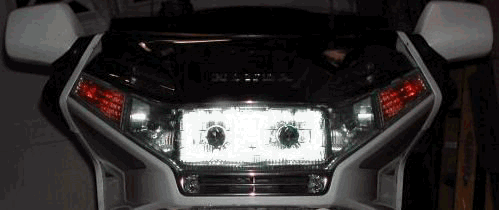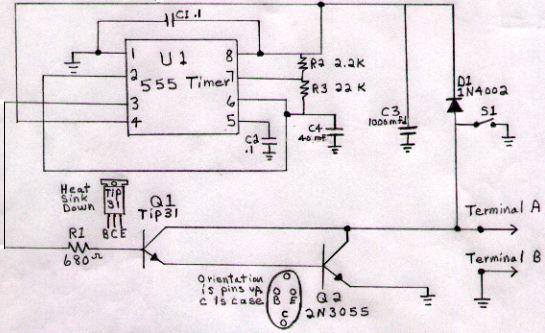A Good Headlight Modulator
by Mick Lindley

This page is dedicated to ALL motorcycle riders and their safety. Years ago before daytime running lights on cars became common I began to notice how visible the headlight was on a motorcycle even from a great distance. From that day forward I continue to drive a car with the lights on. On a motorcycle with a modulated (blinking) headlight it is even more visible. What follows is a schematic of a easily built unit costing only about $8.00 . It may be much less if you have a well stocked junk box. It is the most simple circuit I know of, but it really does the job well. I get at least one email a week saying my headlight modulator is illegal because the light goes out completely. The above picture is not an actual picture of my headlight. It is the magic of computer graphics.
I am asked to build these units often. However, the design does not meet federal requirements for manufactured headlight modulators. This prohibits me from building and selling them. This project is on the easy to moderate level for building. I will try to place some pictures on the site very soon along with some step by step instructions.
Disclaimer: If you build and use this unit you are on your own. Don't come complaining to me about any negative results. The unit DOES NOT meet the federal requirements for "manufactured" headlight modulators due to the fact you must manually turn it off at night. Also, it can be set to blink slower thereby making it much more visible to oncoming traffic, but more annoying to drivers in front of you. Are we really so stupid that we can't flip a switch when it gets dark? The feature could be adapted to this unit but I felt it was not worth the effort. Notice the unit only has 12 parts. However, it works as well or maybe even better than anything you can buy.
Headlight Modulator Schematic

| C1 .1 mfd | C2 .1 mfd | C3 1000 mfd | C4 40 mfd + or - | Q1 Tip31 | Q2 2N3055 |
| R1 680 ohms | R2 2.2 k | R3 22 k | U1 555 timer | D1 1N4002 | S1 spst |
Blinking is controlled by the oscillation of U1. A voltage pulse (high) from pin 3 makes Q1 conduct thereby causing Q2 to conduct and take the load of the bulb to ground. Terminal A goes to the ground side of the bulb. Terminal B goes to chassis ground. Positive 12 vdc is supplied to the bulb in the usual manner by existing connections. Do not disturb it. Positive 12 vdc is supplied to the circuit by C3. C3 is charged every time the bulb blinks off and easily retains enough voltage to supply the circuit. The case of Q1 and Q2 must be isolated from ground. Q1 requires no heat sink. Q2 should have a suitable heat sink, preferable finned and about 2 x 2 inches minimum. The value of C4 may be changed to make the bulb blink slower or faster. Increase the value of C4 to make it blink slower, and decrease it to make it blink faster.
I get emails asking if the unit will cause premature failure of the bulb. I'm sure it will. One of mine goes out about every year or so, but that's not much more often than I used to replace bulbs before using it. You should always carry a spare bulb anyway. What's more important to you a 10 dollar bulb or your butt? When testing the unit I left it on the workbench blinking for more than a month. At first it was to see that the heat sink did not get too hot. Then I just let it go to test the bulb, but it finally became so annoying I turned it off.
I get emails asking is it legal. The scoop from the DOT on headlight modulators states the requirements for "manufactured" units. I take this to mean DIY units are exempt from the requirements. However, an officer or other official may not see it that way. I have ridden about 50k miles with this unit and have only been questioned about it once. It was from a park ranger on the Natchez Trace. I was honest, I told him it was a homebuilt unit and did not meet all the requirements of manufactured units. He said, "it works very well and is quite an attention getter". If you are riding by an intersection and a car is waiting to pull out onto the roadway attention is what you want.
This unit will work equally as well on the brake lights. I run two units on my bike. The brake lights blink continuously as long as the brakes are applied. Some manufactured units blink the brake lights a few times and then stop blinking and keep the brake lights on. I cannot see any logic to this. I want my brake lights to blink as long as I have the brake applied.
Resistors may be 1/4 watt. Capacitors should be rated at 25 volts or more.
S1 should be closed at night to disable the unit and make the light stay on.
Build it, install it, use it, and you will be safer as you ride. See the DOT federal regulations HERE
Questions: Contact me at Mick@LindleyOnline.com